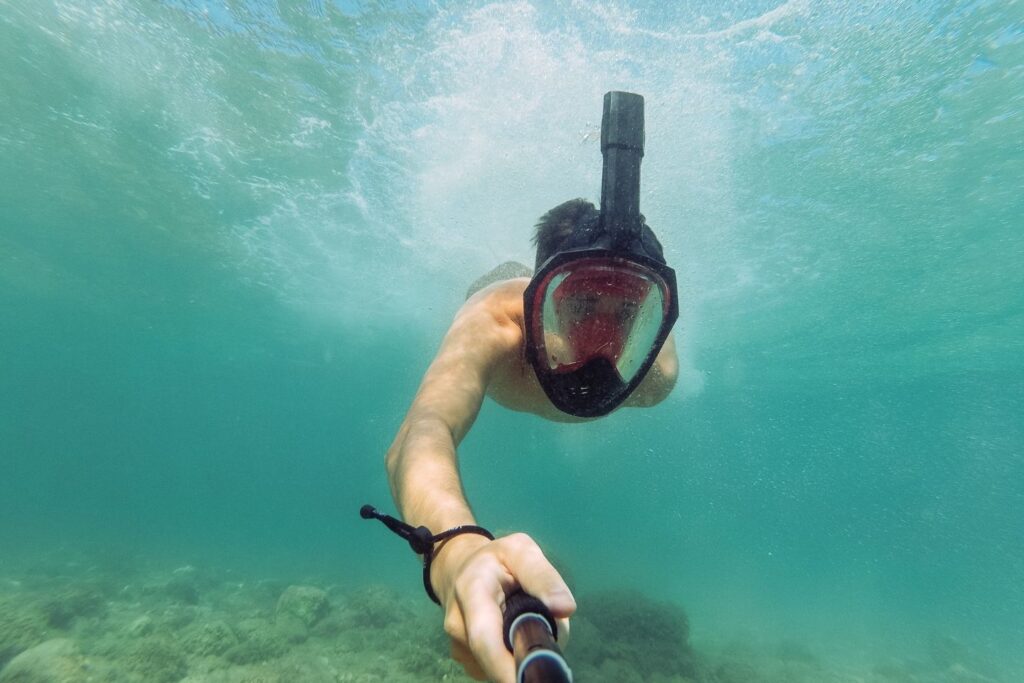
Full face snorkel masks are great for non-diving uses, but they are not intended to be used underwater by people who are SCUBA diving or free diving. It has two air chambers, one on each side of the nose. The purpose of the second chamber is to help prevent fogging and to add buoyancy. When compressed, the first chamber acts like a regulator to keep water out of your eyes and mouth. If you want to see underwater while snorkeling, you should use goggles with a strap that goes over your head. They have a breathing tube that connects both sides of your face so that oxygen can travel from one side through both nostrils so that no water enters them during swimming or diving underwater surfaces.”
Full Face Snorkel masks are intended for non-DIVE snorkeling.
The full face snorkel mask is intended for non-diving uses. For scuba diving, you should use the best scuba mask. The second chamber helps prevent fogging, and adds buoyancy to the mask. The first chamber acts like a regulator, keeping water out of your eyes and mouth as well as providing an air supply.
When used in accordance with its intended purpose, this type of snorkel mask is safe for use by anyone.
Not to be used by people who are SCUBA diving or free diving.
They are not intended to be used underwater by people who are Scuba diving or free diving. Full face snorkeling masks are intended for non-diving uses, such as swimming in pools and lakes, hiking on shorelines with clean water, paddling around in canoes/kayaks/rafts, etc.
A full face snorkel mask air chambers
it has two air chambers, one on each side of the nose. The first chamber is used to keep water out of your eyes and mouth, while the second chamber helps prevent fogging and adds buoyancy.
The second chamber
The purpose of the second chamber is to prevent fogging. When you exhale through your nose or mouth (or both), warm moist air is expelled into a cold environment which causes condensation on your mask’s lenses. This can make it difficult for you to see underwater and could irritate skin if left untreated for too long. To combat this effect, some manufacturers have incorporated an anti-fog coating onto their masks’ lenses that help repel water droplets from forming on them in the first place.
However, these coatings often wear off after repeated use and may even become less effective over time as they become worn down by scratches or abrasions caused by sand particles when cleaning off your mask after every use which makes sense since we’re talking about something that gets dragged across beaches all day long! You’ll want a snorkel with an extra chamber where water can collect instead so it doesn’t sit directly against those sensitive areas where corrosion might occur if left untreated; this way any condensation has somewhere else go besides directly onto those sensitive areas where corrosion might occur if left untreated…
When compressed
- When you press the button on the first chamber, it releases air and allows water to come in. This is how it works as a regulator.
- The second chamber does not have a button to release air, so it’s intended for use as a buoyancy device only.
Should use goggles with a strap
If you want to see underwater while snorkeling, you should use goggles with a strap that goes over your head. Goggles are better than masks because they are more comfortable and durable. They can also be used for other activities besides snorkeling and diving, such as swimming or waterskiing.
For what they are great?
Snorkeling is not the same as scuba diving, so you cannot use full face snorkel masks for scuba diving or free diving. However, if you’re looking for a way to enjoy swimming without having water in your face, then these devices may be right up your alley!
Conclusion
Full face snorkel masks are great for non-diving uses but not diving uses. They can be used for diving if you take care to keep your head above water and avoid getting water in the mask. However, this is not what these masks are intended for and can cause problems if you try using them underwater.
